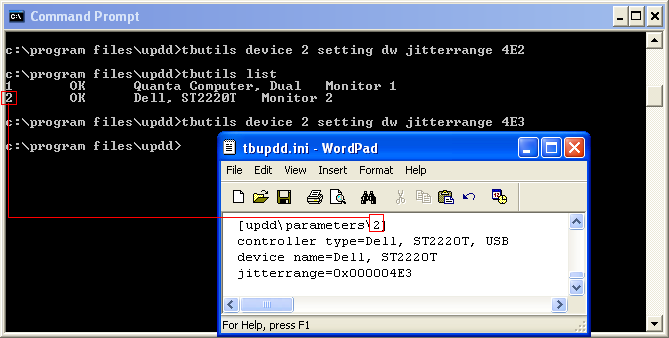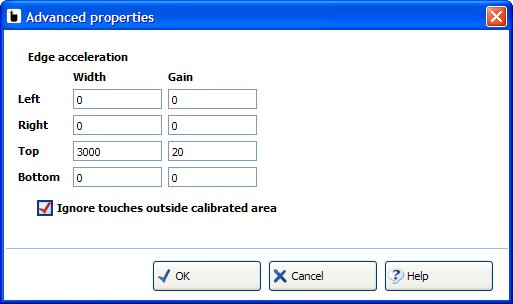Useful driver settings
|
As discussed elsewhere in our documentation the driver’s setting are held in the UPDD settings file TBUPDD.ini. This document relates to UPDD version 5.1.x and above.
Some of the more common settings can be adjusted via the UPDD Console, others are purely for internal use, but some can enable / disable functionality that may be desired in certain scenarios and this document seeks to highlight such settings.
Some settings can be adjusted via the UPDD Console. Where this is not available, such as CE, Solaris etc, the settings can be adjusted with the UPDD command line utility.
Settings can be related to a device, so are specified at a device level and others cover all devices so set at the higher all device level. e.g. All devices - tbutils nodevice setting dw <setting> <value> TBUPDD.ini placement = [UPDD\parameters]
Single device – tbutils [device=n] setting dw <setting> <value> TBUPDD.ini placement = [UPDD\parameters\N]
Commands that do not specify a Device number/Selector are acting on the first installed device.
Current values can be retrieved with the tbutils get parameter.
Typically the command line utility is invoked from a Windows Cmd dialog or a Linux or Mac OS X terminal program, as per this Windows example:
In the above example the system has 2 UPDD devices. The Dell touch screen is on Monitor 2 and has a UPDD device handle of 2. The command has been used to change the jitterrange value for the Dell touchscreen.
Some useful settings are listed below:
Important note – when using tbutils to change settings, if the command needs to use quotes (“ “) because of spaces in the setting name it is important to use quotes from the keyboard and not cut and paste from the documents. The document may carry ‘smart quotes’ whereas the command must have ASCII quotes. If the command looks correct but issues a SYNTAX error “SYNTAX: tbutils {adddevice <id> [name] [COM port]” then double check the quotes.
|
||||
|
Setting |
Value |
Device |
OS |
Purpose |
|
Edge Acceleration left edge gain left edge width right edge gain right edge width top edge gain top edge width bottom edge gain bottom edge width |
dword |
Single |
All |
It may be required to be able to push the cursor to the extreme edge of the screen, especially to invoke features that are associated with the cursor reaching the extreme edge such as with Win 7 and Win 8 extended touch mode. This feature can also be useful under Mac OS X, such as the showing a hidden Dock or the option to run individual applications in full screen mode.
To cater for the need to be able to place the cursor to the extreme edges there is an advanced setting in UPDD (UPDD Console, Properties, Advanced) to accelerate the cursor toward the edge of the screen as the stylus approaches the edge. The values shown below work well:
The setting shown work well. To set via tbutils: Tbutils setting dw "top edge gain“ 14 Tbutils setting dw "top edge width“ BB8 |
|
Stylus0only (0=zero) |
dword |
Single |
All |
Surpress multi-touch processing when supporting a multi-touch device. Only post data from 1 stylus to the OS and application. Other stylus data is suppressed. Useful in MT aware OS if you want to support single touch gestures but disable dual or multi-touch gestures and input. 0, the default, is normal processing; 1 activates the ignoring of stylus > 0. |
|
Screensavertracking |
dword |
All |
Win |
Tracks the state of the system’s screen saver setting (screen saver active or monitor in low power state) and does not post a mouse click to the OS when in this state. A mouse position event is posted allowing the state to be exited without performing any action that a click at the given location would entail. 0, the default, is normal processing; 1 activates the ignoring of touch whilst in this state. |
|
“show systray” |
dword |
All |
All |
Disable UPDD system tray/menu bar option. Next time the aidaemon task is loaded (normally at system startup) this setting determines if the system tray icons are shown. 1, the default, is to show the system tray icon; 0 disables activates the ignoring of touch whilst in this state. |
|
Eepromreadsilent |
dword |
All |
All |
Suppress eeprom read dialog issued by driver when reading eeprom |
|
“Anchor Mouse” “Anchor liftoff” |
dword dword |
Single All |
All All |
Return cursor to previous position after touch on device. Time delay in milli-seconds to return cursor after touch – defined in Hex. Default is 3E8 (1000ms) hardcoded, 1F4 (500ms) by default in .ini file |
|
jitterrange |
dword |
Single |
All |
Increase jitterrange, the value used by UPDD to calculate a stationary stylus, such as in Interactive Touch click mode. Customer could not get right click to be generated due to excessive jitter of stylus. |
|
Mouse Emulation |
|
|
|
|
|
“event mode 0” “Interactive touch time” Motion |
String dword dword |
Single Single Single |
All All All |
Set Interactive Touch and touch time for right click tbutils setting sz "event mode 0" "Interactive Touch" tbutils setting dw “interactive touch time” 64 No pen down/up functions (no clicks) – Stylus motion only tbutils setting sz “event mode 0” None Click and drag mode (pen down on touch, up on lift off with no motion) tbutils setting sz "event mode 0" "Touchdown Left" tbutils setting dw Motion 0 |
|
Calibration related |
|
|
|
UPDD calibration function will set all required orientation settings if using 4 calibration points or more. However, in cases where you need to set these manually these are the settings involved |
|
Invertx |
dword |
Single |
All |
Inverts X movement |
|
Inverty |
dword |
Single |
All |
Inverts Y movement |
|
swapxy |
dword |
Single |
All |
Swaps both X and Y |
|
“calibration style” “calibration points” |
string dword |
Single Single |
All All |
Calibration uses a text mode calibration process if the name of the calibration style is Custom2point or Custom4point. A Linux customer needed to set the settings for this calibration mode without using the UPDD Console tbutils setting sz “calibration style” Custom2point tbutils setting dw “calibration points” 2 |
|
Mac Gesture related |
|
|
|
|
|
Disable Action These settings relate to the action to be performed by the gesture are show how to set for no action. e.g. tbutils setting dw “gesture action double tap” “no action” These settings are held in the [updd\parameters] section of tbupdd.ini file. gesture action double tap=no action gesture action drag=no action gesture action five finger splay=no action gesture action five finger squeeze and splay=no action gesture action five finger squeeze=no action gesture action force drag=no action gesture action force press=no action gesture action four finger drag=no action gesture action four finger splay=no action gesture action four finger squeeze and splay=no action gesture action four finger squeeze=no action gesture action four finger swipe down=no action gesture action four finger swipe left=no action gesture action four finger swipe right=no action gesture action four finger swipe up=no action gesture action one finger swipe left from right edge of screen=no action gesture action one finger swipe right from left edge of screen=no action gesture action pinch and spread=no action gesture action pinch=no action gesture action press and tap=no action gesture action press=no action gesture action rotate left=no action gesture action rotate right=no action gesture action rotate=no action gesture action spread=no action gesture action tap=no action gesture action three finger double tap=no action gesture action three finger drag=no action gesture action three finger swipe down=no action gesture action three finger swipe left=no action gesture action three finger swipe right=no action gesture action three finger swipe up=no action gesture action three finger tap=no action gesture action two finger double tap=no action gesture action two finger drag=no action gesture action two finger swipe left from right edge of screen=no action gesture action two finger swipe left=no action gesture action two finger swipe right from left edge of screen=no action gesture action two finger swipe right=no action gesture action two finger tap=no action gesture gesture press visual feedback=0x00000000 gesture menu icon visible=0x00000000 gesture pass touches to ios simulator=0x00000000 Cursor position These settings relate to the cursor position during the gesture and should be set if the cursor is to be repositioned under the gesture: e.g. tbutils setting dw “gesture action option double tap override reposition cursor” 1 These settings are held in the [updd\parameters] section of tbupdd.ini file. gesture action option double tap override reposition cursor=0x00000001 gesture action option drag override reposition cursor=0x00000001 gesture action option five finger splay override reposition cursor=0x00000001 gesture action option five finger squeeze and splay override reposition cursor=0x00000001 gesture action option five finger squeeze override reposition cursor=0x00000001 gesture action option four finger drag override reposition cursor=0x00000001 gesture action option four finger splay override reposition cursor=0x00000001 gesture action option four finger squeeze and splay override reposition cursor=0x00000001 gesture action option four finger squeeze override reposition cursor=0x00000001 gesture action option four finger swipe down override reposition cursor=0x00000001 gesture action option four finger swipe left override reposition cursor=0x00000001 gesture action option four finger swipe right override reposition cursor=0x00000001 gesture action option four finger swipe up override reposition cursor=0x00000001 gesture action option pinch and spread override reposition cursor=0x00000001 gesture action option pinch override reposition cursor=0x00000001 gesture action option press and tap override reposition cursor=0x00000001 gesture action option press override reposition cursor=0x00000001 gesture action option rotate left override reposition cursor=0x00000001 gesture action option rotate override reposition cursor=0x00000001 gesture action option rotate right override reposition cursor=0x00000001 gesture action option spread override reposition cursor=0x00000001 gesture action option tap override reposition cursor=0x00000001 gesture action option three finger double tap override reposition cursor=0x00000001 gesture action option three finger drag override reposition cursor=0x00000001 gesture action option three finger swipe down override reposition cursor=0x00000001 gesture action option three finger swipe left override reposition cursor=0x00000001 gesture action option three finger swipe right override reposition cursor=0x00000001 gesture action option three finger swipe up override reposition cursor=0x00000001 gesture action option three finger tap override reposition cursor=0x00000001 gesture action option two finger double tap override reposition cursor=0x00000001 gesture action option two finger drag override reposition cursor=0x00000001 gesture action option two finger swipe down override reposition cursor=0x00000001 gesture action option two finger swipe left from right edge of screen override reposition cursor=0x00000001 gesture action option two finger swipe left override reposition cursor=0x00000001 gesture action option two finger swipe right from left edge of screen override reposition cursor=0x00000001 gesture action option two finger swipe right override reposition cursor=0x00000001 gesture action option two finger swipe up override reposition cursor=0x00000001 gesture action option two finger tap override reposition cursor=0x00000001 TUIO related These setting are used by UPDD-TUIO to run unique instances/ports for each touch screen device. The can be set in the TUIO settings dialog or via the tbutils command line utility.
In the global UPDD parameters section i.e. [updd\parameters]: tuio displays have own host=true You can use the updd command to set this value tbutils nodevice setting sz "tuio displays have own host" true
In the device specific parameters section, i.e. [updd\parameters\#] where # is the device index: tuio host=host name tuio port=port number You can use the updd command to set this value Tbutils device 1 setting sz "tuio host" "nnn.nnn.n.n" Tbutils device 1 setting dw "tuio port" 0x00000nnn
Example:
[updd\parameters] tuio displays have own host=true
[updd\parameters\1] tuio host=192.168.0.1 tuio port=0x00000D05
[updd\parameters\2] tuio host=192.168.0.2 tuio port=0x00000D06
Note that the "tuio displays have own host" setting must be set to the string value "true" instead of an integer value like 0x00000001. |
||||

